
The first dedicated British minelayer cruiser
With the unusual pennant number M23, HMS Adventure was the first dedicated minelaying cruiser of the Royal Navy. Inspired by WWI German minelayer cruisers, she was built in the 1920s but saw action in the Second World War, with a famous commander in 1928-1929 John H. D. Cunningham. Not only she was tailored to carry and lay a large number of mines (most cruisers had that capability), she was fitted with diesels to ensure the best range, also a first. She acted with the Atlantic fleet as a minelayer from 1939 to 1944, before being converted as a landing craft repair and accommodation ship. She also inspired the Abdiel class built in 1939-41.
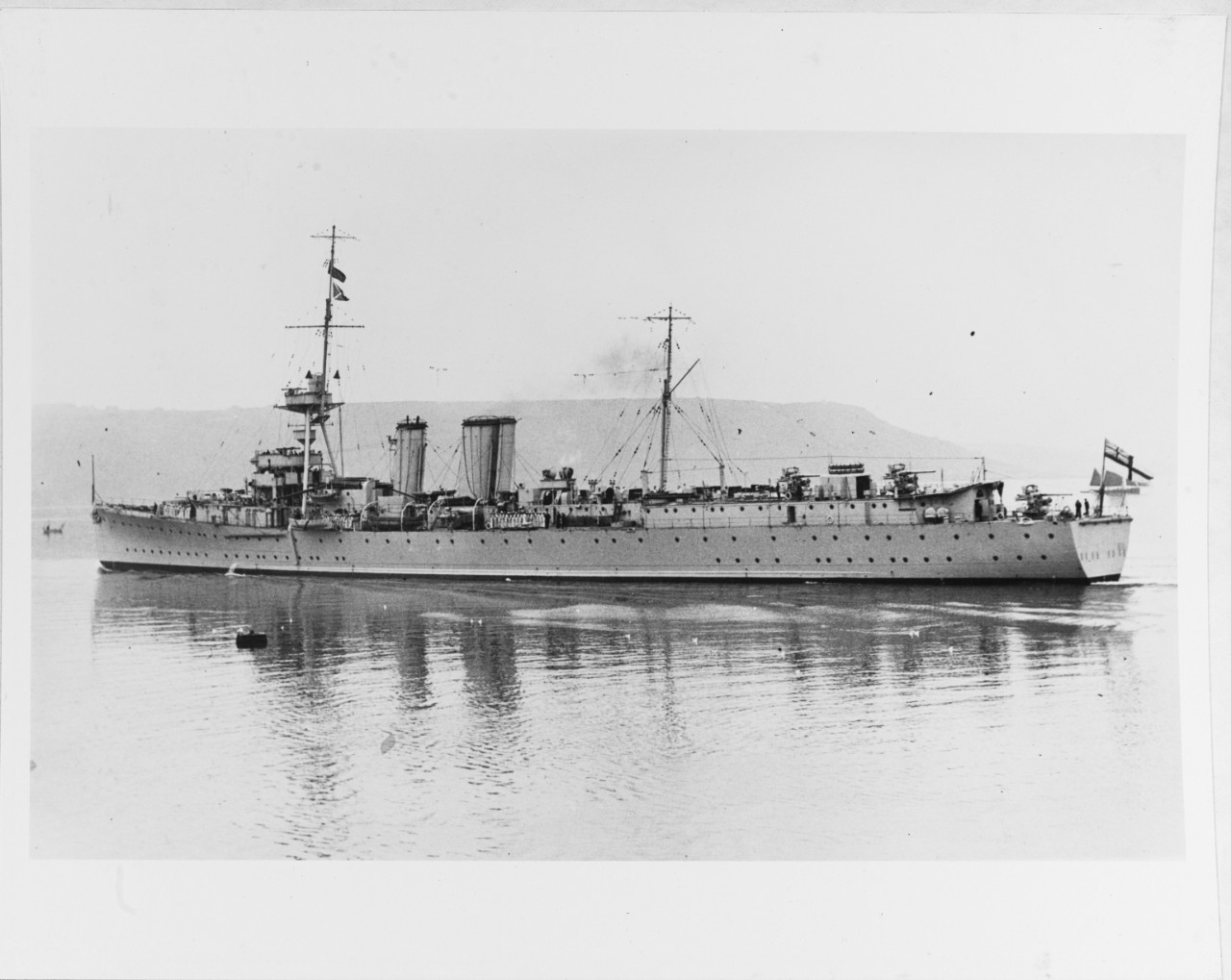
HMS Adventure as completed.
Design Development
The path leading so such experimental concept was at first dictated by the simple need to replace the converted WWI HMS Princess Margaret, but her design was influenced by the German minelayeng cruisers like SMS Brummer and Bremse. Initial requirements came out in 1919, urging both a large mine capacity and good cruising range as prime design objectives. The mineload was to be carried internally also contrary to the usual practice, and thus, to allow a better service of the mines by the crew and better protection from the elements. This however, imposed a particular lighting and aeration.
This particular requirement forced the adoption of a long and ininterrupted internal deck, and a main deck above for a roomy and tall hull. Attention was also given to the stern, which had specially designed chutes and a tailored transom shape, a first at that time. The latter was supposed to clear up the mines faster, but the concept was not sufficiently tried in real conditions, at least for minelaying purposes.
Design in detail
The mine deck presented four sets of rails, running the length of the hull down to the stern chutes. This transom (flat in marine term) stern, was envisioned by engineers to improve cruising efficiency, but more about that later. The hull was reminiscent of the standard “D” class, and for simplification she borrowed much of the superstructure also to gain time. So in essence she was a Danae class with a mine deck. This much simplified the design time, but led to some compromises as well. Although she did not shared the same powerplant (but had the same output), but her range doubled. Her hull was both longer and larger, 6,740 long tons in standard displacement versus 4,850 tons standard. Her draught was about the same however at 14 ft 6 in (4.42 m), 17 ft 3 in (5.26 m) full load versus 14.5 ft (4.4 m) and 16.5 ft (5.0 m) when fully loaded.

Stern view of HMS Adventure before reconstruction
Hull construction & protection
HMS Adventure’s hull measured as built 520 feet (158.50 m) long overall and 500 feet (152.40 m) between perpendiculars. Her beam was 59 feet (17.98 m) – again versus 46.5 ft (14.2 m) (47 ft (14 m) on HMS Despatch and Diomede, for a draught of 17 feet 2 inches (5.23 m) deeply load. Displacement reached 6,740 long tons (6,850 t) standard, up to 8,370 long tons (8,500 t) deeply loaded; It retake most of the internal compartimentation solutions on the D-Class, separating her six Yarrow-type water-tube boilers from the Parsons geared steam turbines.
Protection-wise, Conway’s states she was protected by one inch of steel (25 mm) on her side and that’s it. Precise informations are not available. It was clearly not the main focus of engineers; To compare, the D class cruisers had a much more extensive protection between a main belt 2.25 inches (57 mm), 1 in (25 mm) over her machinery, steering gear and gunshields. We can at least suppose this was the same on her side, since she also shared the same artillery and needed extra protection on her vitals as well;
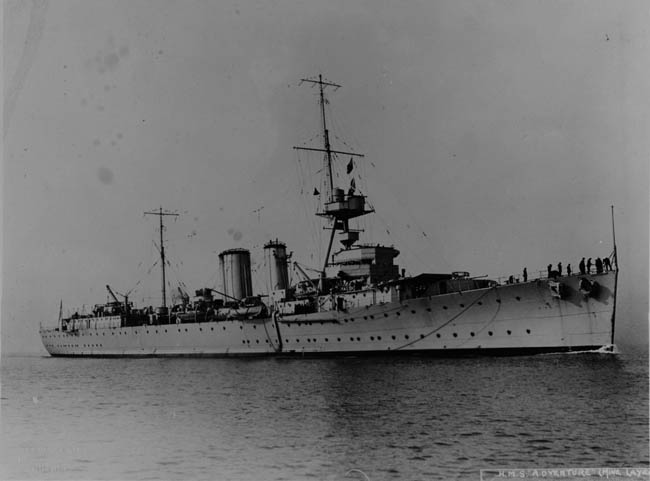
hms Adventure as completed
Controversy and reconstruction
In 1920, Marine British engineering started to play around with new hull shapes and discovered the usefulness of the transom stern. Basically chopping the aft section as it started tapering made the ship faster. This also saved materual, and thus cost while keeping the advantages of a longer ship. In a budget-restrcicted time, this seemed a good idea. At least as far as the theory went: It was tested in basin, and worked in full scale, so as the HMS Adventure (the name also reflecting her innovative stance) was chosen to evaluate it. She became the world’s first ship with a transom stern as a test.
In the first sea trial, it was found out that that transom stern worked perfectly as predicted. However it has been very simplified as the taper “tricks” the water, into thinking the ship is longer than it really is. The ship went faster for the same output as a result, but by creating a pool of “dead water” filling in the space where the tapered hull should be. This “pool” followed the ship around. It was fine for any ship. Less so for a minelayer !
Indeed this dead water also caused by such a form meant that mines tended to be sucked back into the hull after launch. As discovered when she made her first operational tests. An obviously dangerous situation for a minelayer and as a result, she was rebuilt with a traditional cruiser, or rounded, stern, increasing the length by 19 ft (5.8 m). At a time without computers, fluid mechanics were still relatively unknown, and that particular shape, on paper seemed rational, but the wake created behind the ship was quite complex, resulting in counter-vortexes that could have been only worked out using computer calculations based on modern models. Nothing at that time was available. But the result of these was that some mines, after clearing of the ship tended to be drawn back in the wake, counter-intuitively as it seemed. At least the clean wake, well known, from a standard “pointy” stern was more predictable.
HMS Adventure’s innovative mixed propulsion
Propulsion was decided early one to maximize range over speed, even though top speed needed to be sufficient to fler battleships. The initial plant was as installed in the C-class cruisers, but to increase cruising efficiency, she was given a novel diesel-electric plant for tests, propellers being driven by either set of turbines or diesels through gearboxes. We also can see it as a primitive CODOG. The diesel-electric plant howeve rproved troublesome and was removed entirely during her second repair inactivation by 1941, along with the small diesel exhaust trunked up the second funnel.
So this powerplant comprised two Parsons single reduction geared steam turbines fed by six Yarrow water-tube boilers, and four Vickers 8-cylinder diesel engines working with two alternators and two electric motors.
Armament
The main problem with the design was that the mine deck was already above her metacentric center, so she was already off-balanced. Engineers knew they could not have her armed like a standard D class cruiser. Instead of the six BL 6-inch (152.4 mm) L/45 Mark XII gun completed by four DP/AA smaller guns and two torpedo tubes banks, HMS Adventure was equipped with the following:
-Four QF 4.7-in Mark VIII (single mountis HA Mark XII)
-Four QF 2-pounder Mk.II (single mounts HA Mk.II)
-280 Large Pattern mines or 340 small pattern mines
Modifications
By 1941 during her repairs, HMS Adventure was fitted with a Radar for the first time, a Type 291 air warning type, installed at the masthead. She was also fitted with a Radar Type 285 on the high-angle HACS Director Control Tower (foremast spotting top), and a Type 272 centimetric target indication radar on the foremast, below the spotting top. In xxx she was rearmed with eight QF 2-pounder Mk.VIII (Single octuple mount HA Mk.VIII) and eight 0.5 in (13 mm) Vickers machine guns (two quadruple mounts Mk.I). In 1944 her electronics suite was unchanged, but nine 20 mm Oerlikon AA guns on single mounts P Mk.III were added to her decks, two of which replaced the old quad tandem Vickers HMGs. As a repair ship for landing craft this was unchanged but if course her mines were get rid of.
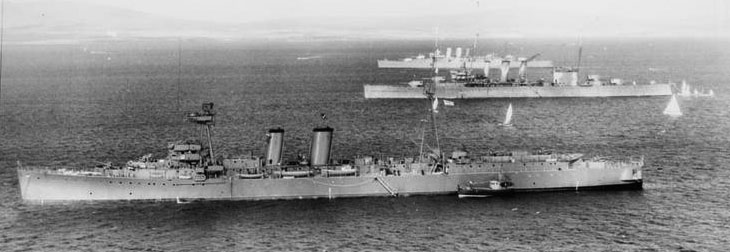
Image from the Imperial War Museum (cropped)

Image from the US Naval History & Heritage Command
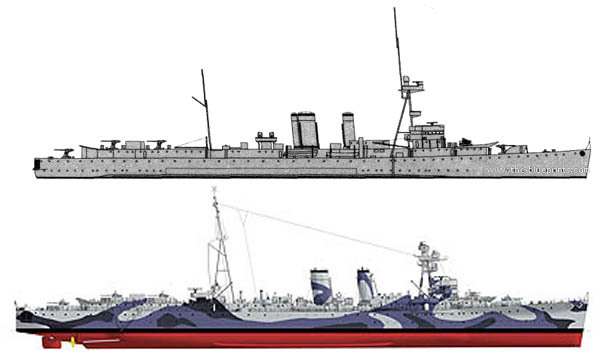
Comparison between the 1928 and 1942 versions of the cruiser
HMS Adventure (1925) |
|
| Dimensions | 164.3oa x 18 x 4.42m (539 x 59 x 14 ft 6 in) |
| Displacement | 6,740 t standard, 8,370 t FL |
| Propulsion | 2 shafts geared steam turbines, 4 diesel electrics, 6 Yarrow boilers, 40,000 shp (30,000 kW) |
| Speed | 27.75 knots (51.39 km/h; 31.93 mph)/17 kts diesels |
| Range | 4,500 nmi/12 kts, 1,820 nmi (3,370 km; 2,090 mi)/25 kts |
| Armor | Belt, gun shields 2 in, armored deck 2 in |
| Armament | 4 × 4.7-in Mk VIII QF, 4 × 2-pdr Mk.II DP QF, 280-340 mines |
| Crew | 392-560 wartime |
Scr/Read More
Logs on naval-history.net
On the dreadnoughtproject.org
On navypedia.org
On battleships-cruisers.co.uk (also 1935-39 logs)
Charles Carslon memories
On reddit.com
wik
On uboat.net
collections.museumsvictoria.com
maritimeoriginals.com
Books: Gardiner, Robert; Chesneau, Roger, eds. Conway’s all the world’s fighting ships 1921-47
British National Archives at Kew, London
Brown, David K. (2010). The Grand Fleet: Warship Design and Development 1906–1922. Seaforth Bublishing
Brown, David; Majeski, David V.; Buxton, Ian L. & Smythe, A. J. (2001). Cruiser-Minelayer HMS Adventure, Warship International.
Cocker, M. P. (1993). Mine Warfare Vessels of the Royal Navy: 1908 to Date. Airlife Publishing
Haarr, Geirr H. (2013). The Gathering Storm: The Naval War in Northern Europe: September 1939–April 1940.
HMS Adventure – Ship’s Log – November 1939, The National Archives, Kew
Lenton, H. T. (1998). British & Commonwealth Warships of the Second World War. Naval Institute Press.
Rohwer, Jürgen; Hümmelchen, Gerhard (1992). Chronology of the War at Sea 1939–1945. Greenhill Books
Nore Command War Diary ADM 199/375 & War History ADM 199/1454
Board of Inquiry Report ADM 1/10857
J P Foynes “Battle of the East Coast 1939–1945).
HMS Adventure’s career (1927-45)
Interwar service
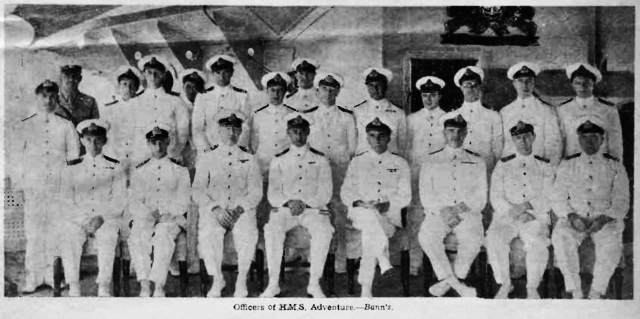
Officers onboard posing in Shanghai, June 1938
As the 13th ship bearing that name, HMS Adventure was laid down at Devonport in November 1922 and launched in June 1924. She was commissioned when completed in May 1927. Her first commander between 1928 and 1929 was the future First Sea Lord John H. D. Cunningham. Not much is known after that, and she probably alternated training and cruisese between the Channel, North Atlantic, Mediterranean but also Asia. This was interrupted by a reconstruction of her stern early on. To read more about this, see the recollection of Colin Jones’s service from 1935 on battleships-cruisers.co.uk (link above in the sources). Her motto was ‘Dare all’ and heraldic Badge was a silver anchor between two shields on a back field, bearing the Cross of St George and the Irish Harp respectively.
Wartime service – 1939
On the outbreak of the War the RN strategy comprised an operation of blockade as in WWI against Germany, and so the laying a series of defensive minefields in British coastal waters for defense, and English Channel, were the first phase, preventing attacks. From 11 to 16 September 1939, HMS Adventure (Under command of Capt. A.R. Halfhide) sailed with the smaller coastal minelayer HMS Plover and converted train ferries Shepperton and Hampton for the mission, escorted by HMS Cairo and destroyers of the 19th Destroyer Flotilla. In all they laid 3,119 mines in the Straits of Dover. This secured the east end of the Channel from any penetration by submarines.
This started on the night of 24-25 Oct 1939, departing Immingham to laid mines off Flamborough Head escorted by HMS Cossack and HMS Jupiter and back to Immingham. The 30 October 1939 she sailed for another mission off the Humber escorted by HMS Janus and Juno, and when done, she sailed to Rosyth. HMS Adventure was deployed for a Yorkshire coast large minefield. On early November she departed to lay mines off the Firth of Forth with HMS Juno and Jupiter again, and moved to Portsmouth on 12 Nov 1939 with HMS Basilisk and Blanche.
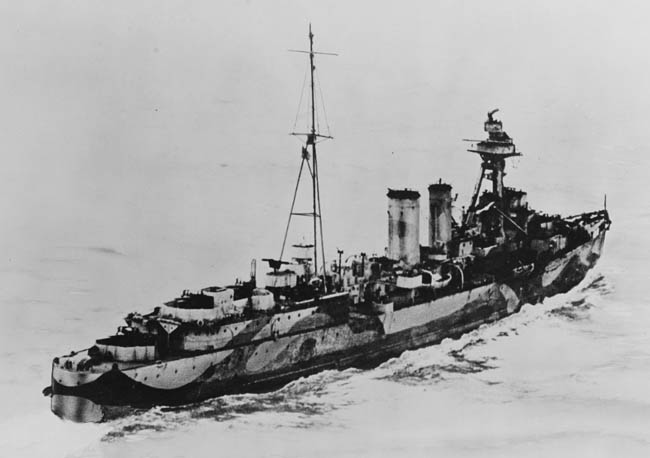
In 1942, credits USN Naval Historical Command
The night of 12/13 November 1939 saw a sortie by German destroyers Z 18, Z 19, Z 20 and Z 21, laying themselves a minefield in the Thames estuary. HMS Adventure hit a mine there shortly after 05:00 hours near the Tongue Light Vessel, disabled. The injured were transferred to HMS Basilisk while the HMS Blanche (Lt.Cdr. R.N. Aubrey) stayed in close defence. Thy were proceeded to safety when HMS Blanche herself also hit a mine around 08:30, starting sinking by the stern. The tug Fabia tried to take her in tow, but she capsized and sank before, lossing two crew with twelve injured by the explosion and flooding.
In all, 23 of HMS Adventure’s crew were killed or fatally injured. The bridge was wrecked also with fittings thrown against bulkheads and down hatchways. The Medway tugs had her in tow from Ramsgate until she reached Chatham Dockyard for repairs. Originally floating mines were blamed but nowadays it is clear magnetic mines were used. Captain Arthur Robert Halfhide left command on December 1939 and the whole crew was reaffected elsewhere while a one year long repair took place.
Wartime service – 1940
Capt. Norman Vere Grace took his functions on 18 August 1940, during repairs, and remained so until 12 August 1942. HMS Adventure returned to service only by October 1940 and the context of operations already changed.
On 30 November, she was met en route by HMS Kashmir, Kipling, Jackal from Plymouth for a patrol to lay the minefueld GQ 1. HMS Adventure departed Milford and the destroyers were detached shortly before noon, arriving at Plymouth in the second half of the afternoon. HMS Adventure was back to Milford Haven in the evening. On 29 December at 10:55 she was escorted with HMS Kashmir and Jersey, Jupiter to Plymouth, and with the last two she departed Milford Haven to lay minefield GQ 2. On 30 December she was back in Plymouth after completing her mission.
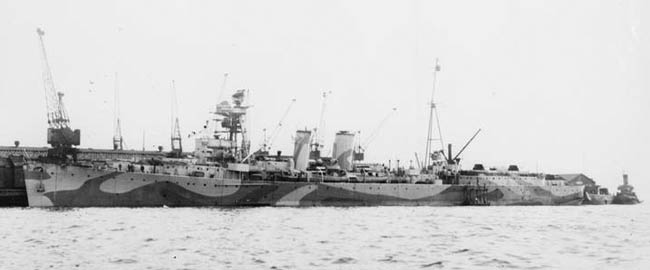
May 1943 IWM
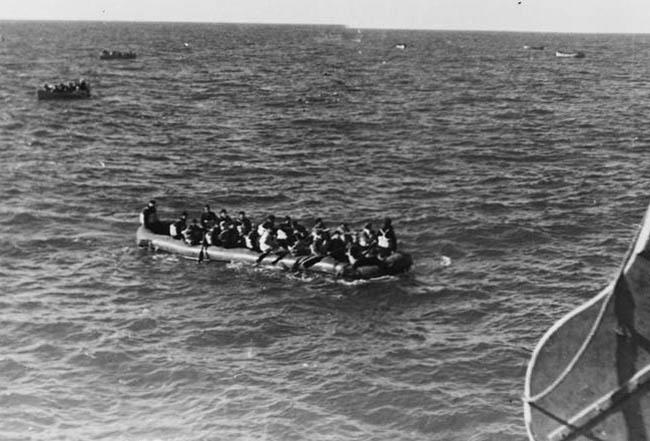
Blockade Runner’s end, 10 April 1943, Bay of Biscay, Silvaplana
Wartime service – 1941
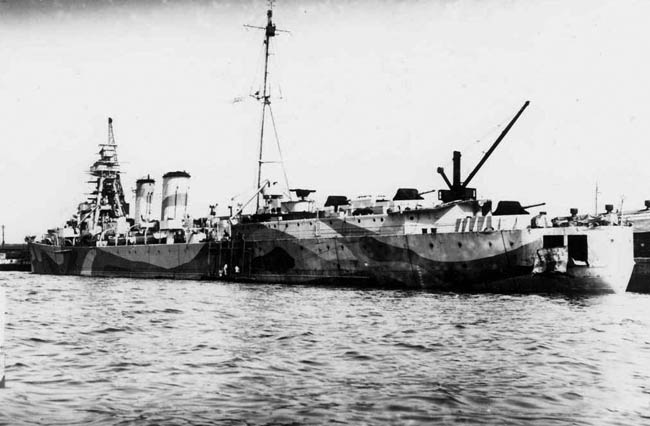
Stern view, 1942
In January 1941, HMS Adventure was in mission when she again struck by a mine in Liverpool Bay. The damage was again considerable and she was towed out of harm but out of action for five months. It’s only by July 1941 that she sailed out with the Operation EF task force sent for the raid of Kirkenes and Petsamo in Norway. This was made in support of the Soviet Union, and on 1st August she arrived in Murmansk with a cargo of parachute mines to be used by the Russian Naval Aviation. She stayed in Murmansk until sailing home at the end of the year.
Wartime service – 1942
In February 1942, HMS Adventure was due to make another run to Murmansk. However the lucky cruiser was damaged in a collision en route, in the Clyde. This cost her further repairs for three months. It’s only by June 1942 that HMS Adventure was active again. She was tasked to take part in a decoy operation called Operation ES, covering the passage of convoy PQ 17. Capt. Ronald George Bowes-Lyon took command on 12 Aug 1942, and stayed until December 1943. The winter of 1942/43 saw her making fast re-supply missions to Gibraltar and the Mediterranean in general.
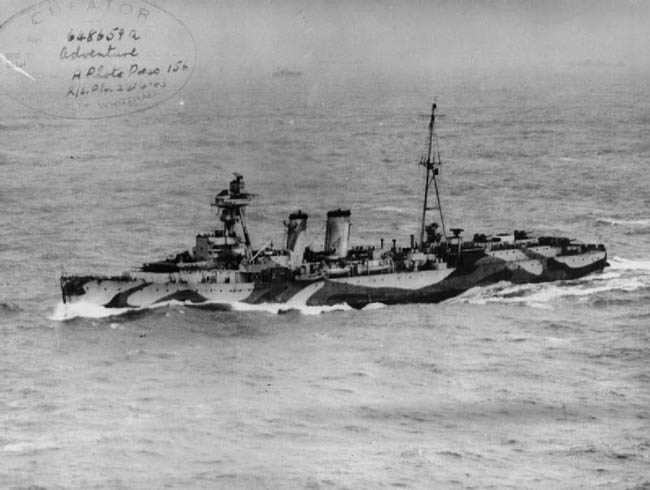
HMS Adevnture in 1943 – IWM
Wartime service – 1943
In April 1943, HMS Adventure wasn sent to try spotting and sinking the German blockade runner Irene. On 10 April, KMS Irene was intercepted at last, and sunk off the coast of Spain. In November 1943, HMS Adventure was sent home for a conversion as a tender and repair ship, for landing craft. By that popint she has done 20 mining operations throughout the Western Approaches and North Sea. But the conditions changed and minelaying was no longer a priority. Specialized ships were urgently needed and the large interdeck space was ideal for her task. Cdr. Charles Bettesworth Sanders of the RNVR (New Zealand) took commad on December 1943.
Wartime service – 1944-45
During the Normandy landings of 1944 HMS Adventure was deployed off Mulberry B, as a support and repair vessel, landing repair parties on 19 June which were hard at work to recover damaged landing craft, needed elsewhere. Many of these were used indeed in Operation Anvil (southern France). Her following captains were William Bagot Walker from 1st January 194 and Cdr. Charles Bettesworth Sanders of the RNVR until 20 March, then A/Capt. Alan MacGregor Sheffield until August, Cdr. George Alan Kenneth McCombe (RNVR) until 7 Jan 1945 and Cdr. Alan Holt Davies (RNVR) until 27 Apr 1945. Her last active captain was Donald Scott McGrath until the summer of 1945. HMS Adventure was decommissioned in August 1945, placed in reserve and stricken, but not sold for scrap before 1947 to Thos W Ward. and broken up at Briton Ferry.

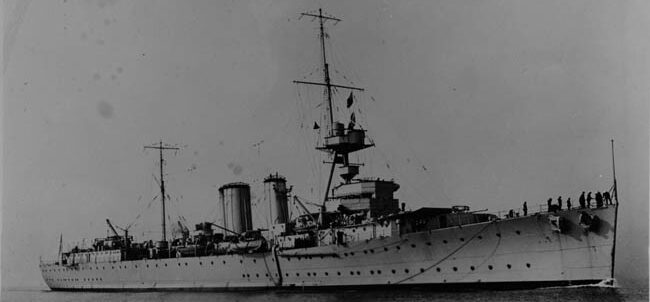

 Latest Facebook Entry -
Latest Facebook Entry -  X(Tweeter) Naval Encyclopedia's deck archive
X(Tweeter) Naval Encyclopedia's deck archive Instagram (@navalencyc)
Instagram (@navalencyc)





 French Navy
French Navy Royal Navy
Royal Navy Russian Navy
Russian Navy Armada Espanola
Armada Espanola Austrian Navy
Austrian Navy K.u.K. Kriegsmarine
K.u.K. Kriegsmarine Dansk Marine
Dansk Marine Nautiko Hellenon
Nautiko Hellenon Koninklije Marine 1870
Koninklije Marine 1870 Marinha do Brasil
Marinha do Brasil Osmanlı Donanması
Osmanlı Donanması Marina Do Peru
Marina Do Peru Marinha do Portugal
Marinha do Portugal Regia Marina 1870
Regia Marina 1870 Nihhon Kaigun 1870
Nihhon Kaigun 1870 Preußische Marine 1870
Preußische Marine 1870 Russkiy Flot 1870
Russkiy Flot 1870 Svenska marinen
Svenska marinen Søværnet
Søværnet Union Navy
Union Navy Confederate Navy
Confederate Navy Armada de Argentina
Armada de Argentina Imperial Chinese Navy
Imperial Chinese Navy Marinha do Portugal
Marinha do Portugal Mexico
Mexico Kaiserliche Marine
Kaiserliche Marine 1898 US Navy
1898 US Navy Sovietskiy Flot
Sovietskiy Flot Royal Canadian Navy
Royal Canadian Navy Royal Australian Navy
Royal Australian Navy RNZN Fleet
RNZN Fleet Chinese Navy 1937
Chinese Navy 1937 Kriegsmarine
Kriegsmarine Chilean Navy
Chilean Navy Danish Navy
Danish Navy Finnish Navy
Finnish Navy Hellenic Navy
Hellenic Navy Polish Navy
Polish Navy Romanian Navy
Romanian Navy Turkish Navy
Turkish Navy Royal Yugoslav Navy
Royal Yugoslav Navy Royal Thai Navy
Royal Thai Navy Minor Navies
Minor Navies Albania
Albania Austria
Austria Belgium
Belgium Columbia
Columbia Costa Rica
Costa Rica Cuba
Cuba Czechoslovakia
Czechoslovakia Dominican Republic
Dominican Republic Haiti
Haiti Hungary
Hungary Honduras
Honduras Estonia
Estonia Iceland
Iceland Eire
Eire Equador
Equador Iran
Iran Iraq
Iraq Latvia
Latvia Liberia
Liberia Lithuania
Lithuania Mandchukuo
Mandchukuo Morocco
Morocco Nicaragua
Nicaragua Persia
Persia San Salvador
San Salvador Sarawak
Sarawak Uruguay
Uruguay Venezuela
Venezuela Zanzibar
Zanzibar Warsaw Pact Navies
Warsaw Pact Navies Bulgaria
Bulgaria Hungary
Hungary

 Bundesmarine
Bundesmarine Dutch Navy
Dutch Navy Hellenic Navy
Hellenic Navy Marina Militare
Marina Militare Yugoslav Navy
Yugoslav Navy Chinese Navy
Chinese Navy Indian Navy
Indian Navy Indonesian Navy
Indonesian Navy JMSDF
JMSDF North Korean Navy
North Korean Navy Pakistani Navy
Pakistani Navy Philippines Navy
Philippines Navy ROKN
ROKN Rep. of Singapore Navy
Rep. of Singapore Navy Taiwanese Navy
Taiwanese Navy IDF Navy
IDF Navy Saudi Navy
Saudi Navy Royal New Zealand Navy
Royal New Zealand Navy Egyptian Navy
Egyptian Navy South African Navy
South African Navy






























 Ukrainian Navy
Ukrainian Navy dbodesign
dbodesign